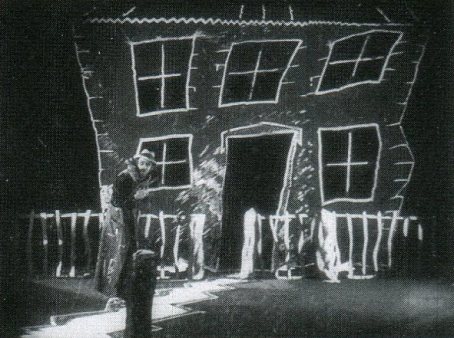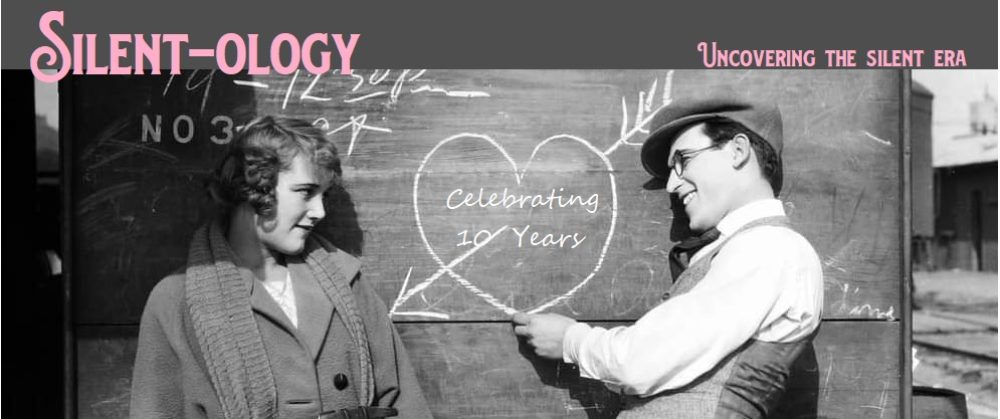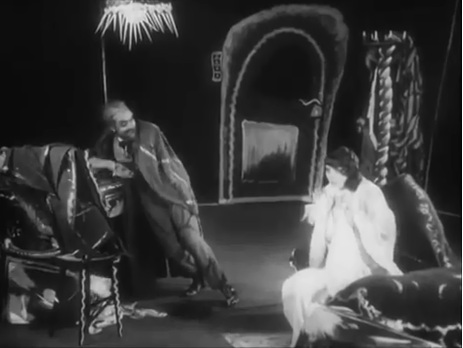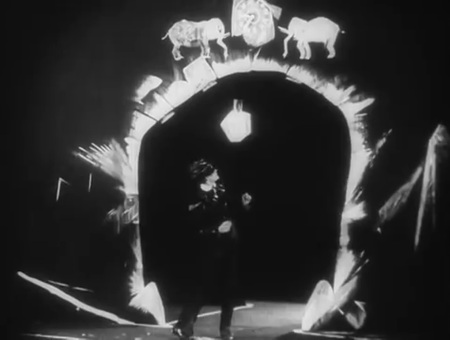So if The Cabinet of Dr. Caligari took German Expressionism and ran with it, From Morn To Midnight took it, ran with it, jumped on a motorcycle and rode it screaming straight through a brick wall.
Yes, my friends, if you haven’t experienced From Morn to Midnight–and no one has–you’ll never know what sights I’ve seen. I stumble through my ordinary life in a daze, keenly aware that the vast majority of people in the world get by without knowing this film exists. I look at them with misty eyes, those ordinary people with their ordinary lives (who are usually texting) and sigh. For I know, my friends. I know. While walking to the post office box to drop off my Netflix DVDs, while trying to be patient in the checkout lane at the grocery store behind the old lady with 16 coupons, while ordering the toppings on my Subway sandwich in a way that isn’t awkward, I know. True! Nervous–very, very dreadfully nervous I had been and am; but why will you say that I am mad? Wait, that’s Poe–never mind.

Although I’m sure he’d feel at home with this film.
To say this film is obscure is like saying fingers tend to come with hands. On IMDb The Cabinet of Dr. Caligari has over 150 reviews. 166, to be exact. From Morn to Midnight? Three. And one of them is from a guy who always posts as an imaginary German count (he’s very insightful though, go check it out!).
From what I could discover, this odd duck of a movie was based on an Expressionist stage play (“Von morgens bis mitternachts”) by the über popular German playwright Georg Kaiser. Kaiser wrote it in 1912, although it wasn’t performed until 1917. In 1920 Karlheinz Martin directed the film version, presumably with a mad glint in his eyes. And the producers took one look at that film version, presumably blew their tops, and it never made it to the cinema. It may never have seen the light of day if it hadn’t been given a 1922 release in…Japan, of all places.

Actually, that kind of makes sense.
The film was found in Tokyo’s National Film Center in 1959 and has since been meticulously restored and made available on DVD by Edition Filmmuseum, for which I’m very grateful. Because how can you not be grateful for From Morn to Midnight?

‘Tis sublime.
When you watch this film (as you should) you may have trouble concentrating on the story–the art design claims every second of your attention. Filmed entirely against black backdrops, the sets are designed to look as flat and artificial as possible. Bright spotlights cast shadows on the backgrounds. Everything down to the last stick of cardboard furniture is distorted like a cartoonist’s fever dream and then dabbed and outlined with white paint–even the clothes and faces of the actors. Every bristle line of the brushstrokes is visible, just in case you forgot how stylized it all is. The entire effect is like a black light party that traveled back in time.
The designers are clearly saying “Yeah, it’s all fake. It’s faker than fake. I’ll bet you’ve never seen anything so fake. That’s right, bourgeois…we just blew your minds.”
Talk about your creative choices. I don’t know this for sure, but I suspect Karlheinz Martin watched Caligari, bounded to his feet and shouted “Ach, I can do that too!!” and then dashed away to find a script and a set designer with an open mind.
Alright, so who was that set designer? That’s the main question I came away with.
He was Robert Neppach, who would later work with directors like F.W. Murnau and who had created designs for many stage productions. I wondered, did Neppach get the idea for those black and white sets on his own or did the filmmakers want it to look a certain way? How could I find out?
Here is what the bank scene looked like in Kaiser’s original play (from a 1922 book). This is clearly an ordinary-looking bank and the actors’ clothes are not full of paint. The black background is the only similarity:
 Okay, let’s think. Did director Martin (this was his first film by the way) have a liking for experimental art? Why yes he did; before trying out filmmaking he had become very successful at putting on “expressionist” dramas, like Ernst Toller’s 1919 play Transfiguration. And here’s what a set from Transfiguration looked like:
Okay, let’s think. Did director Martin (this was his first film by the way) have a liking for experimental art? Why yes he did; before trying out filmmaking he had become very successful at putting on “expressionist” dramas, like Ernst Toller’s 1919 play Transfiguration. And here’s what a set from Transfiguration looked like:

That’s familiar.
The art designer on Toller’s play? Robert Neppach. Bingo! Collaboration, noted.
You’ll notice, though, that From Morn to Midnight‘s goes far, far beyond Transfiguration and even beyond The Cabinet of Dr. Caligari. Why? (Yes I’m asking too many questions, but trust me these are but the merest fraction of the ones I have.)
Martin and company, like many experimental filmmakers at the time, wanted to show film could go beyond the stage–it could be its own art form. And on the practical side they had to get creative since silent films were silent, and they couldn’t include all the dialogue from Kaiser’s play. A Cineaste article states:
Kaiser’s works, particularly From Morning to Midnight and The Burghers of Calais…were noted for their long monologues, exclamatory to the point where coherent statements all but disappeared…Without Kaiser’s idiosyncratic language, Martin tried to capture his radical spirit in the film’s sets and costumes, striving for a cinematic Gesamtkuntswerk (“Total Work of Art”).
(Man I love research. Without it, how else would I learn the word Gesamtkuntswerk?…I took Spanish in high school.)
Now that that’s settled, let’s take a closer look at the story of this zany showpiece of German-Expressionism-Gone-Wild, shall we?
The plot is concentrated around a bank cashier in a small town. He’s at work when he sees this rich woman, and she…well, he meets her. Wait, maybe he helps her with her money. So anyways, he thinks she has the hots for him–no, he has the hots for her, so…so then he…err…
You know, I’ve watched this film several times and thanks to the distracting sets I can’t for the life of me remember what it’s actually about. Let me go watch it again.

…Dumdee dumdee doo…
*72 minutes later*
Okay, I think I’ve got it this time. I really do.
*sneaks a look at IMDb*
Alright, here goes (spoilers, although the odds are you’ll forget to pay attention to the plot on the first try):
A bank cashier helps a wealthy “Italian Lady” customer. He becomes intensely drawn to her, and thinks she is drawn to him too. After her visit, he begins to feel very dissatisfied with his ordinary life.
He steals a large sum of money from the bank, and offers the lady a new life with him. She refuses, telling him he was mistaken about her feelings. She also tells him she already has a son, which I guess is the ultimate deal breaker.
The cashier leaves, goes home, and amid all the love of his tender family decides “Ach, I want more out of life!” and runs off to the city. There he lives in luxury, trying and failing to find joy in wine, women, and odd cyclist races until he is persuaded by a Salvation Army girl (who has popped up throughout the movie) to give up his ill-begotten life. Repenting, he hands out all his money to a greedy crowd. He’s abandoned by the crowd, and only the Salvation Army girl loyally stands by him.
At the end of the film, he is arrested by the police for his crimes. Who had tipped them off? The Salvation Army girl. That’s just cold.
(End spoilers, although I’m still not 100% sure this is really what’s going on.)
From Morn to Midnight is a tale much beloved by the intellectual set at the time: the middle-class man at odds with capitalist society. In this case the middle-class man himself is a disappointment. The cashier (played intensely by Ernst Deutsch), impulsively acts on selfish desires and abandons his family. The end shot, where he poses as a Christ-like figure, apparently refers not only to the “Man who was betrayed” but to Nietzche’s self-conscious book Ecce Homo (this just happened to be the last book the philosopher wrote before going crazy).
Not a frame of From Morn to Midnight is wasted in creating a surreal atmosphere. The titles have spiky letters. In the beginning, the bank doors open on their own, and the cashier fades into the scene like a ghost. Visions of death occur in the form of women’s faces transforming into skulls. Repetitive shots of a bike race are taken with a distorting mirror and lit to make the bikers seem to glimmer. The actors throw themselves into the “modern” acting style, complete with broad, quick gestures.
Does it work?…in a way. From Morn to Midnight set out to be Expressionist, and Expressionist it certainly was. But in my opinion it’s not another Caligari. Its sets are so bizarre, so deliberately over the top that it overwhelms its own message. The audience can only take so much. No wonder theater owners balked at it.
In Caligari, the design was supposed to evoke the mind of a madman. Maybe From Morn to Midnight is trying to do something similar. Everything around the cashier is flat and reduced to two tones because he feels life has become flat and unsatisfying. But, considering the history behind the tamer-looking theatrical production, one suspects that deep down the film went to extremes mainly…because it wanted to.
At any rate, I declare From Morn to Midnight to be an overlooked gem of avant-garde cinema that deserves to be seen, if only because it cannot be unseen. It’s available on the Edition Filmmuseum DVD, and pops up on YouTube too. It makes for some excellent Halloween viewing. Just make sure no uninitiated viewers are around, since they will become…quite confused.
Oh, and I forgot to mention that all the titles are in German and it has a terrible modern soundtrack. HAVE FUN!!
—
Sources:
Eisner, Lotte H. The Haunted Screen: Expressionism in the German Cinema and the Influence of Max Reinhardt. 2nd revised edition. Translated by Roger Greaves. Berkeley and Los Angeles: University of California Press, 2008.
Jacques, Juliet. “From Morning to Midnight.” Cineaste, Vol.XXXVI, No.2, 2011.
Jones, Bouton. “Expressionism and Caligarisme.” http://www.boutonjones.com/pub/caligarisme.cfm
Kaiser, Georg. “From Morn to Midnight: A Play in Seven Scenes.” Translated by Ashley Dukes. New York: Brentano’s Publishers, 1922.
Kracauer, Siegfried. From Caligari to Hitler: A Psychological History of German Film. New Jersey: Princeton University Press, 1947.
“German Expressionism.” http://cinecollage.net/german-expressionism.html
“Von morgens bis mitternachts.” http://www.edition-filmmuseum.com/product_info.php/info/p110_Von-morgens-bis-mitternachts.html







This was another fun read. I especially liked your opening and your nice discoveries about the story behind those Crazytown sets. I admire your ability to find enjoyment in such obscurity and impenetrability!
Oh, it was a blast, although it really did take a ludicrous amount of viewings to get the film “figured out.” And finding out detailed information–or any information at all–was a challenge, that’s for sure! I did read that the shelving of From Morn to Midnight made other filmmakers balk at the idea of trying out crazy set designs themselves, so that does add some extra significance to film history there.
I’d never even heard of this movie! Great post!
…And once you watch it, you’ll never forget it! And thanks!
The visual style really stuck in my mind, but I remember not loving this one as much as I expected when I bought the DVD. I think I would appreciate it more on a rewatch. I liked the score(s), though. Did you watch with the SchlagEnsemble or the Yati Durant score?
I belieeeve it was the SchlagEnsemble score. If they specialize in scores that sounds like elevator music banged on tin cans, that’s them! 😉
It’s not that I mind modern scores to silent films per se–for instance, many of the scores on Kino’s Avant Garde of the ’20s/30s set are fantastic in my opinion. But it has to flow with the film naturally, not turn the film into a mere “artsy backdrop” for pretentious music. I should re-watch the film with the Durant score!
For what it’s worth, I watched this film a good 5-6 times before writing about it (it’s bizarreness…fascinated me) and it just seems far too conscious of how artsy it is to really work. It’s still a can’t-miss film, though!
it just seems far too conscious of how artsy it is to really work
Yes, that’s accurate! this film is a bit of an evolutionary dead-end but an interesting one.
Sorry for the comment spam, by the way, I’m home sick and therefore reading the internet …
Comment away, I love it!! And it’s definitely not everyday that I get to discuss From Morn to Midnight. 😀
Pingback: Presenting… | Silent-ology
Pingback: A Halloween Post Roundup! | Silent-ology
Pingback: 7 German Expressionist Films You Probably Haven’t Heard Of | Silent-ology
Pingback: Animated Insects And Animal Tales–The Art Of Ladislas Starevich | Silent-ology
Isn’t that the house from Keaton’s two-reeler One Week?
Seriously, I 💕 this blog.
Perhaps it’s the house’s troubled cousin? 😀 I’m really appreciating your visit, Nonchalant!
Pingback: Films of 1920: From Morn to Midnight | Kim Thompson (Author)
Gran reseña, aunque leo un poco de incomprensión respecto al asunto de la Dama Italiana y su hijo. El cajero cree erroneamente que el joven que acompaña a la Dama Italiana es el amante de ésta, pero en realidad es su hijo adolescente. Cuando ella lo menciona el cajero comprende su error: No está tratando de seducir a una mujer mundana y frívola sino a una madre que viaja en compañía de su hijo. Esto lo perturba bastante.
-Great review, although I read a bit of misunderstanding regarding the matter of the Italian Lady and her son. The cashier mistakenly believes that the young man accompanying the Italian Lady is her lover, but in reality he is her adolescent son. When she mentions it, the cashier understands his mistake: He is not trying to seduce a worldly and frivolous woman but a mother who travels with her son. This disturbs him quite a bit.
Good catch, Elisabeth. That little clarification adds a lot to that scene–and explains some of Deutsch’s expressions, too (which could be kind of baffling otherwise!).
I appreciate your review. It helped guide my understanding of the film. I think you’re right. It was a bit hard to follow the plot with so much going on in the background. But you’re writeup helped. I was looking for more crazy after liking caligari and this certainly fits the bill. I did find the plot a little bit drawn out longer than needed and I got a little bored but the visuals were treat so I’m glad I watched it.
Glad you enjoyed it, Dan! It’s…not a film you’re going to forget soon, is it? 😉
Hi, I watched ‘From Morgens bis Mitternachts’ for the first time last night (thanks to Youtube). It was quite an experience and I felt like I had to read more about it. That’s how I came across your website and your review. It was a fun read! I might spend some time exploring your website. I am into German Expressionism. I believe I have watched most of the key GE films, minus a handful. There might be more available online. A lot of GE films are not all available on DVD/Blu-ray, or they are a bit pricey to order from Edition Filmmuseum, especially since I am not in Germany. Do you have any recommendations?
Hi Gwen, glad you stopped by! Let’s see, another interesting GE film is Raskolnikov (1923), an adaptation of Crime and Punishment. It uses GE pretty well, although not quite to Caligari’s level. Genuine (1920) is pretty bad, but does have ambitious sets and the ridiculous story is worth a laugh. 😉
Thanks, Lea. I had heard of the two, but I haven’t watched them yet. They are both available on YouTube, in different versions/lengths. Raskolnikov sounds interesting. I just had a quick look at Genuine, it does look very promising!
Pingback: “But Are The Shadows Painted?”–Some Thoughts On “True” German Expressionism | Silent-ology
Pingback: Recapping The San Francisco Silent Film Festival 2024! (Plus A Giveaway) | Silent-ology